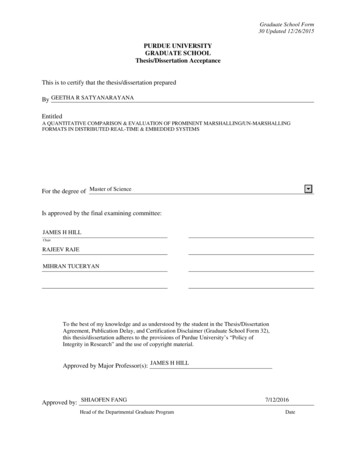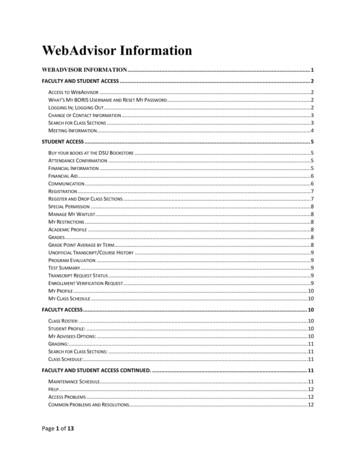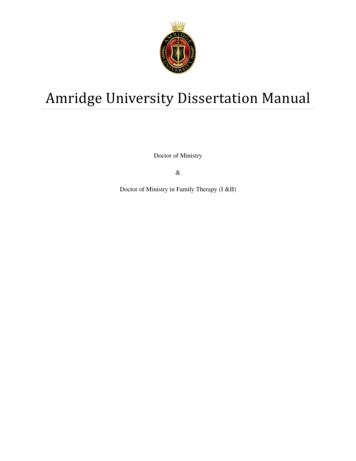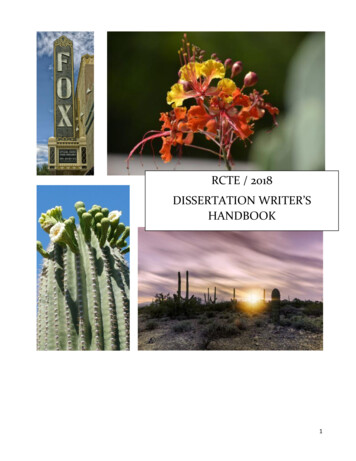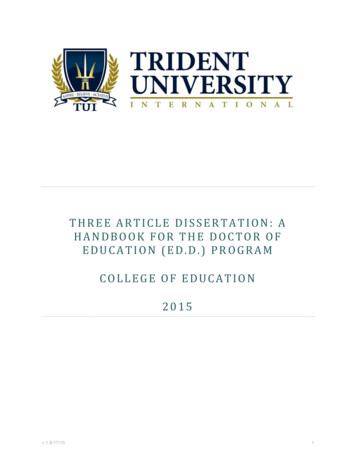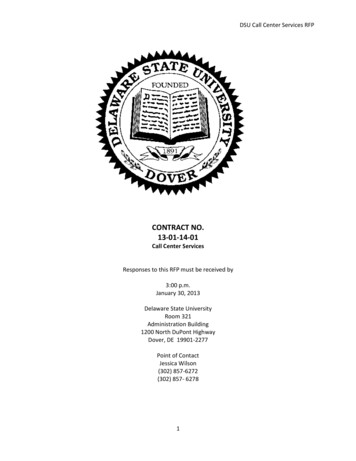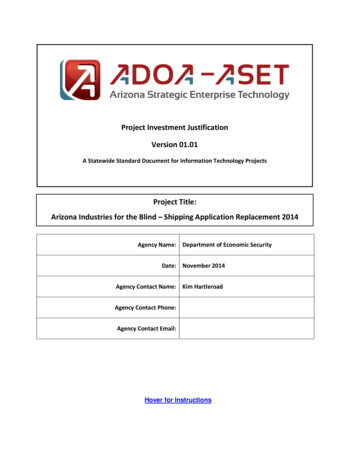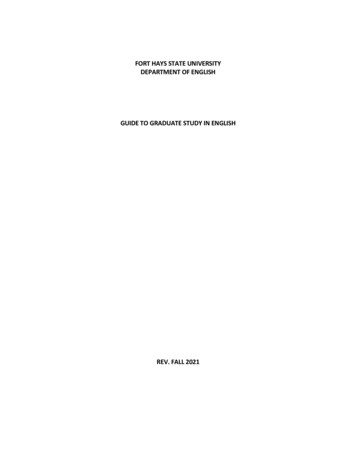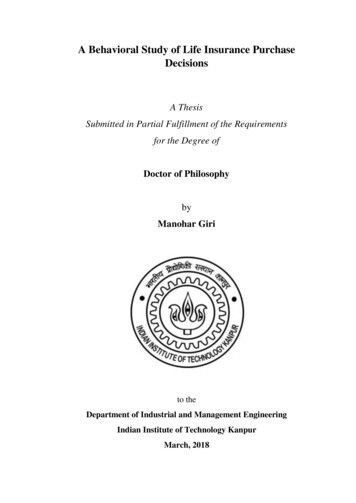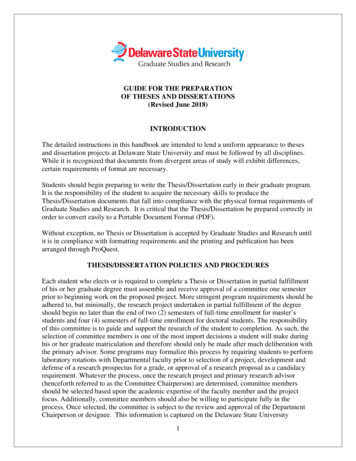
Transcription
GUIDE FOR THE PREPARATIONOF THESES AND DISSERTATIONS(Revised June 2018)INTRODUCTIONThe detailed instructions in this handbook are intended to lend a uniform appearance to thesesand dissertation projects at Delaware State University and must be followed by all disciplines.While it is recognized that documents from divergent areas of study will exhibit differences,certain requirements of format are necessary.Students should begin preparing to write the Thesis/Dissertation early in their graduate program.It is the responsibility of the student to acquire the necessary skills to produce theThesis/Dissertation documents that fall into compliance with the physical format requirements ofGraduate Studies and Research. It is critical that the Thesis/Dissertation be prepared correctly inorder to convert easily to a Portable Document Format (PDF).Without exception, no Thesis or Dissertation is accepted by Graduate Studies and Research untilit is in compliance with formatting requirements and the printing and publication has beenarranged through ProQuest.THESIS/DISSERTATION POLICIES AND PROCEDURESEach student who elects or is required to complete a Thesis or Dissertation in partial fulfillmentof his or her graduate degree must assemble and receive approval of a committee one semesterprior to beginning work on the proposed project. More stringent program requirements should beadhered to, but minimally, the research project undertaken in partial fulfillment of the degreeshould begin no later than the end of two (2) semesters of full-time enrollment for master’sstudents and four (4) semesters of full-time enrollment for doctoral students. The responsibilityof this committee is to guide and support the research of the student to completion. As such, theselection of committee members is one of the most import decisions a student will make duringhis or her graduate matriculation and therefore should only be made after much deliberation withthe primary advisor. Some programs may formalize this process by requiring students to performlaboratory rotations with Departmental faculty prior to selection of a project, development anddefense of a research prospectus for a grade, or approval of a research proposal as a candidacyrequirement. Whatever the process, once the research project and primary research advisor(henceforth referred to as the Committee Chairperson) are determined, committee membersshould be selected based upon the academic expertise of the faculty member and the projectfocus. Additionally, committee members should also be willing to participate fully in theprocess. Once selected, the committee is subject to the review and approval of the DepartmentChairperson or designee. This information is captured on the Delaware State University1
Appointment of an Advisory Committee for the Master’s/Doctoral Degree form and should besubmitted to Graduate Studies and Research as a part of the student’s file adhering to thetimelines as described. This and all graduate matriculation documents may be found athttps://sgaes.desu.edu.Minimum Committee Requirements:It is not the intention of Graduate Studies and Research to supersede Departmental or Collegecommittee requirements, but rather provide guidelines for minimum committee composition. Incases where these requirements are more stringent, Graduate Studies and Research will defer, but at aminimum all committees will meet the following standards. A Thesis Committee (MA or MS) shallconsist of four (4) members at the rank of Assistant Professor or above, one of whom is external tothe Department in which the work was completed. A Dissertation (Ed.D. or Ph.D.) Committee shallconsist of five (5) members at the rank of Assistant Professor or above, one of whom shall beexternal to the University. A doctoral student completing a case/project study may have (4) membersat the rank of Assistant Professor or above, one of whom shall be external to the University.Thesis/Dissertation DefenseThe oral defense, also known as the oral examination, shall be scheduled in adherence with theUniversity’s calendar (approximately 8 weeks before the end of the semester) and as noted atGraduate Studies and Research’s website: https://sgaes.desu.edu. The student is required tosubmit the final document to the committee for review at least one week (7 days) prior to thescheduled defense. The Chair of the committee, however, should schedule periodic committeemeetings to gauge the student’s progress. It is also strongly recommended that the committeerequire periodic submissions of the document as it is developed and provide timely feedback,thus allowing the student adequate time to defend his or her research, make corrections followingthe defense, receive feedback and approval from committee members and the Dean of Graduate,Adult and Extended Studies, as well as submission of the final document for printing andpublication, all of which are graduation requirements.Registration for Thesis/Dissertation Research CreditWhile the style manual selected for the Thesis or Dissertation is designated by the Department orCollege in which the program resides, page layouts and margin requirements as described byGraduate Studies and Research must be adhered to. Students must register for Thesis/Dissertationresearch credit while conducting the required research, and when ready to devote focused time tothe writing and completion of their research document. In cases where programs have segmentedthe development of the Thesis or Dissertation across several courses, the student should follow thisprotocol. It is strongly recommended that the Committee Chair develop a timeline in consultationwith the student and committee members in order to assist the student in meeting the requiredmilestones for a successful outcome. Students must remain registered for Thesis/Dissertationsustaining credit while “active” work on their research documents continues or until theThesis/Dissertation is approved by the Advisory Committee and Graduate Studies and Research.Any student utilizing University resources while working on their Thesis/Dissertation includingfaculty assistance or University facilities are required to enroll for the Thesis/Dissertation course.A lapse of two or more semesters of continuous enrollment (not including summer) will requirereapplication to the School of Graduate, Adult and Extended Studies.2
Thesis/Dissertation GradesA grade of Q is submitted for the student while a Thesis or Dissertation research is in progressand proceeding satisfactorily. If the Thesis or Dissertation is not proceeding satisfactorily, a Ugrade is submitted. If a U grade is submitted, the committee should monitor the student’sprogress very closely. If a second U grade is received, the committee should meet with thestudent regarding progress and submit a memorandum to the Graduate School summarizing theoutcomes of the meeting:(1) Date and time the committee convened?(2) Can the project be revised or changed in scope?(3) Was there a recommendation to change committee members?(4) Was there a recommendation to change programs (MS to MA, Ph.D. to MS, thesis tonon-thesis)?(5) Was the student dismissed from the program due to lack of progress?(6) Was the decision of the committee unanimous?ProQuest Process and SpecificationsUpon completion of the oral defense, the Committee Chair should forward the defense outcomesto Graduate Studies and Research by the posted deadline. Additionally, the outcomes shouldprecede submission of the final Thesis/Dissertation for approval. The final Thesis/Dissertationshould be submitted to Graduate Studies and Research following approval of the AdvisoryCommittee by the posted deadline. This document should include all changes and/or updatesresulting from the oral examination along with the appropriate approvals on theThesis/Dissertation Approval Page. These corrections should be given to the student in writingpreferably at the defense but no later than 5 business days following the defense. The finisheddocument must be submitted online to ProQuest at www.Etdadmin.com/desu. Prior tosubmission, all students will be required to view the ProQuest Submission Tutorial. Thedistribution of bound copies will be as follows at the expense of the student: One bound original (8.5’ x 11.0”) to the University Library; Personal copy(ies) at the student’s discretionThe Committee Chair will submit the appropriate letter grade (A, B, C, D, F) following approvalof the final document by the Dean, School of Graduate, Adult and Extended Studies, andsubmission to ProQuest. This grade will replace (the maximum allowed) previously receivedThesis/Dissertation Q grades for the degree.Copies of the Thesis/Dissertation must be reviewed according to the regulations outlined byGraduate Studies and Research. The Thesis/Dissertation binding process is required and will beprovided by ProQuest after the student has completed the following steps:1. All formatting corrections have been made and approved by the ProQuest Administratorfor Graduate Studies and Research.2. All forms and documents including the Defense Outcomes form, the Revisions forThesis/Dissertation and Signature Approval pages have been submitted and signed by theDean, School of Graduate, Adult and Extended Studies.3. The required number of bound copies of the Thesis/Dissertation have been paid onlinevia ProQuest.3
USE OF COPYRIGHTED MATERIALThe law permits the limited use of extracts and quotations for purposes of illustration andcriticism. This provision covers most quotations in Theses and Dissertations. In most instances,it is not necessary for candidates preparing Theses/Dissertations to obtain permission to quotefrom professional journals in their fields or from copyrighted books.Copyrighted items, such as photographic copies of pictures and charts, tests, forms andquestionnaires, no matter how short, should never be reproduced without permission.Graduate students are advised to receive permission, from the author or publisher, to quote anyextensive information from copyrighted materials. In most cases, the author or publisher iswilling to grant permission with the condition that acknowledgments are included in thedocument. If a student chooses to copyright his or her Thesis/Dissertation, copies of the writtenletters must accompany the copyright registration.Students should consult with their Thesis/Dissertation Committee Chair and membersconcerning the desirability and the usefulness of copyrighting the document.REPRODUCTIONThe Thesis/Dissertation may be duplicated or reproduced by photocopying, printing additionalcopies, or a comparable process. In all cases, the printing must be of high quality – completelyfree of smudges, gray cast, or any extraneous marks. It is recommended that a laser printer beused.STYLEStyle, footnotes, citations, and bibliographical form of the Thesis/Dissertation should conform tothe conventions prescribed by a standard style manual appropriate to the student’s major field.In some cases, the style employed in major research publications may be appropriate for use in aThesis/Dissertation. Footnotes in the Thesis/Dissertation should be placed in the documentaccording to the respective style manual.Note: The student must select the latest edition of the style manual approved by his or herdepartment, and must consistently conform to the instructions of that manual. However, in casesof conflict and when no specific guideline has been selected, this Thesis/Dissertation Handbooktakes precedence. A word of caution -- never use another Thesis/Dissertation as a model.Examples taken from another Thesis/Dissertation may be out of context, out of date or incorrect.The existence of a particular style or usage in a previously approved Thesis/Dissertation does notestablish a precedent for its continuation.4
FORMAT REQUIREMENTSTypefaceA Times New Roman, 12 point black font is the preferred type. Another font may be substitutedif specified in the guidelines of the respective program. Word processing quality must beconsistent throughout the document; nonstandard fronts are unacceptable. Features such asboldface, underline and italics that improve the readability are acceptable; however, a qualityprinter must be used in black print, but may also include color print where appropriate. Themanuscript must be neat and easily readable, with the same form used throughout. A student indoubt regarding acceptable fonts or prints should consult with the Graduate Student SupportSpecialist. The manuscript should be proofread, and corrected errors should not be detectable.The following common errors must be avoided: Sentences ending a paragraph should not end as a partial line at the top of the next page. All chapters, sections, subheads and table headings of more than one line should besingle-spaced. All large material requiring the use of a landscape page orientation should face to theright. A period or a comma is placed inside quotation marks; colons and semicolons are placedoutside quotation marks. If two words are omitted from a quotation, three spaced periods (called an ellipsis) areinserted at the beginning, middle, or end of the sentence to reflect the omission. Table titles should not be restated on continuous pages. All references cited in the text must be listed in the References section.MarginsThe entire document should have uniform margins of 1 inch around all four sides of the paper.SpacingThe body of the Thesis or Dissertation must be double-spaced using only one side of the sheet.Long quotations, typed as block quotes, should be single-spaced with triple space before andafter. Tables and figures, captions as well as descriptions, footnotes, references, andbibliographic information may use single spacing.The chapter title on the first page of each chapter also has specific spacing requirements. Thereshall be a double space between the chapter, the section title, and the text.Footnotes, if any, shall be numbered consecutively throughout each chapter, indented for the firstline, single spaced and separated from the text by a solid line of 18 spaces. A double space shallbe left between footnotes.PaginationThe pages in the Preliminary material must be numbered consecutively with lower-case Romannumerals, centered at the bottom 1 inch margin. The title page has no page number typed on it,but it is understood to be page “i.” If a copyright page is included, it is not counted in thenumbering.5
Arabic numbers (1, 2, 3) should be used for the remainder of the paper, including the referencematerials. These numbers shall begin with page one of the text, which bears the numbercentered at the bottom of the page, with succeeding page numbers at the 1 ½ ” top right margin.All pages are numbered in sequence, including the first pages of chapter, full-page tables orfigures, and appendices. All Arabic numbers should be placed consistently throughout thedocument.ParagraphsEach paragraph should be indented. A new paragraph should not begin at the bottom of the pageunless there is adequate space for at least two lines.Illustrative Material – paper submissionFor best optic quality, computer generated or digital photos should be laser printed directly ontowhite 25%-100% cotton paper. High color photocopies may also be used.ORGANIZATION OF THE TEXTIn most cases, a Thesis/Dissertation consists of four major parts – abstract, preliminary materials,text, and the references/bibliography. Some documents may also include appendices. Thefollowing is a list of all the major and minor parts, in their usual order of placement.Sequence of Parts of the Thesis or DissertationThe parts of the Thesis/Dissertation or project must be arranged in the following sequence: Title Page Copyright Page (if used) Dedication Page (optional) Acknowledgement Page (optional) Preface (if discipline requires it) Abstract (Required) Table of Contents (Required) List of Tables (recommended if tables are present) List of Figures or Illustrations List of Abbreviations (if used) Text (main body of Thesis/Dissertation beginning with introduction as first chapter) References Appendices Glossary (if used) Index (optional) Back Flyleaf (blank page)**Please draw your attention to the examples provided at the back of this guide book**6
The parts to be included in any Thesis or Dissertation should be determined by mutual agreementbetween the student and his or her committee. Each part of the document is described below indetail.Title PageThe title page should follow exactly the spacing and use of capitalization shown in the sample atthe end of the guide. The top margin is 1 inch and the information is centered. The title can betyped in all capitals or the first letter of each word can be capitalized (with the exception ofarticles). If the title is more than one line in length, it is arranged in an inverted pyramid. Thedate on the title page should be the month and year the degree is to be granted. The name of thedegree sought, and the major department or field of study, is included here. (See sample at theend of the guide) The title page has no preliminary page number typed on it, but it is counted aspreliminary page “i.” Following the date, type all committee members whose names will appearon the top portion of the signed approval page (left justified). Begin the name with the title ofthe person as Dr. James Doe, followed by role on your committee (Committee Chairperson,Committee Co-Chairperson (if applicable), Committee Member and External CommitteeMember), Department and University. The approval page must also be submitted to GraduateStudies and Research with wet signatures for the final approval of the Dean, Graduate, Adult andExtended Studies.Copyright Page (if used)If students elect to have the Thesis/Dissertation copyrighted, please review the ProQuest websiteat http://www.Etdadmin.com/desu for details with this process. For more information aboutcopyright, visit the U.S. Copyright Office via the Library of Congress website atwww.copyright.gov. Keep in mind that if you choose to copyright, you must include a copyrightpage in your document. The copyright page appears on the verso of the title page and legallyprotects the property of the author’s Thesis or Dissertation. There is an additional charge forcopyrighting. If a copyright page is used, it is not counted in the numbering.Dedication (Optional)A dedication gives special tribute to a specific person(s). Most dedications are short, beginningwith the word, “To ” The dedication is typed alone on the page, usually centered. This pageshould have a 1 inch top margin, or the dedication may be typed in the middle of the page (top tobottom). The text of the dedication is double-spaced. The preliminary page number should becentered at the 1 inch bottom margin.Acknowledgments (Optional)When included, acknowledgments should be brief, simple and free of sentimentality or trivia. Itis customary to recognize the assistance of the Advisor and/or Committee Chair, all othermembers of the committee, and only those organizations and/or persons who actually added tothe research. If financial support was provided to make the study possible, credit for suchassistance should be given.The heading ACKNOWLEDGMENTS is typed in the center at the 1 inch top margin. The textis double spaced with the appropriate preliminary page number centered at the bottom margin.7
Preface (Optional)A preface is a statement that either explains the author’s reasons for pursuing this subject matteror provides a personal comment about the subject that would not otherwise be included in thedocument. The heading PREFACE is centered at the 1 inch top margin. The text is doublespaced with the appropriate preliminary page number(s) centered 1” at the bottom margin.AbstractAn abstract must be included with each Thesis and Dissertation submitted to Graduate Studiesand Research. The abstract should be a brief summary of the paper, stating only the problem,procedures used, and the most significant result and conclusions. Explanations and opinions areomitted. The abstract must be approved by the student’s Committee Chair.The abstract margins are consistent with the text of the paper: 1 inch top; 1 inch left; and, 1 inchright and bottom.Please note that the name and title used on the abstract should be the same as used on the titlepage. The faculty Advisor or Committee Chairperson should follow the title and student name.(See sample at the end of the guide)The text of the abstract is typed double-spaced in paragraph form with the first paragraph of thetext beginning one triple-space beneath the advisor/committee chairperson. The first word ofeach paragraph should be indented, consistent with the rest of the paper.Table of ContentsThe Table of Contents is placed immediately after the acknowledgments or preface and containsa listing of all the items that follow. The Table of Contents lists only the items that follow it. Itdoes not include the pages that precede it.The heading TABLE OF CONTENTS is centered at the 1 inch top margin. One double-spacedown from the heading, the words “List of Tables” is typed flush with the left margin. Pagenumbers for each chapter title/heading and each subtitle/subheading are listed on the Table ofContents and should be left flush, beneath the word “List.”The contents begin at the left margin, one double-space below the title. Preliminary items, suchas LIST OF TABLES, are typed flush with the left margin, followed by a series of dots, knownas dot leaders, and the page number typed flush with the right margin. Please note that the Title,Copyright, Dedication, Acknowledgement, and Abstract pages are not listed on the Table ofContents.Following the preliminary items, the word CHAPTER stands alone on a line, centered. Chapterheadings are numbered with Roman numerals, aligned by their decimals. The chapter titles aretyped in capital letters and are worded exactly as they appear in the text.When a title or subheading must exceed one line, the subsequent line(s) should be single-spacedand indented two spaces. Double-spacing is used between each chapter title. If there are8
subheadings included, these should by typed single-spaced with a double-space separating themfrom chapter titles above and below. All subheadings must include subheading numbers whichmust also be included in the text of all chapters preceding the subheading (See sample at the endof the guide).List of Tables (Recommended if tables are present)The list of tables follows the Table of Contents and begins on a separate page. The headingLIST OF TABLES is centered at the 1 inch top margin. The remainder of the page is set upbasically the same as the Table of Contents, double-spaced, with the list of table numbers andtitles. Each table title should be followed by dot leaders and the page numbers. All table titlesmust be listed in order using the exact title (as it appears on the actual table) and the appropriatepage number. Tables should be numbered in the order they appear in the paper, using thenumbering system provided in the style guide selected. Titles of more than one line are singlespaced with second and succeeding lines indented two spaces. Double-spacing is used betweentable titles. Only titles, not explanatory notes, should be included on the list of tables.Tables and Figures/IllustrationsStatistical information is usually set up in tabular form. Tables may be placed on a page withtext or on separate pages. Tables are numbered consecutively and table captions should be inaccordance with the selected style guide. The table is then typed beginning one double spacebelow the last line of the caption, either single or double-spaced.Illustrative material such as graphs, diagrams, photographs, drawings and maps are referred to asfigures. Some of these items may be best included as multimedia files. If the illustration isincluded in the text, it should be inserted as closely as possible to its first reference. Figures arenumbered sequentially throughout the text in Arabic numbers. The placement of figure titles,either above or below the figure, must be consistent throughout the paper.Nothing should be typed on a facing left-hand page. If the table or figure is landscape format,the top should be placed at the 1 inch left-hand margin. Please note that the page numbers on thelandscape pages must appear in the same position and direction as the page numbers on portraitpages. All tables and figures must conform to the specified margin requirements.CHAPTERSThe division of the main text of the paper should be appropriate to the character of the work andin accordance with the practices in the student’s field of study. Normally, the text includes anintroductory chapter, a documentation of previous work in the field, the specific problem to beinvestigated, a complete explanation of the methodology used, a discussion of the results andtheir significance, and a summary. Each major division, usually called a chapter, should beginon a new page. The first page of each chapter has a very specific format. One inch top marginThe heading is centered, typed in all capital letters, and uses standard Arabicdesignations or Roman Numerals (ex: CHAPTER 1 or CHAPTER II).9
Double-space (the equivalent of three single-spaces)The chapter title is centered and typed in all capitalsTriple-space (the equivalent of three single-spaces)First subheading or begin text(See Sample at end of guide)Chapter 1: IntroductionThe introduction chapter of the Thesis/Dissertation is the first chapter and it sets the stage forwhat will be presented in the pages that follow it. The introduction chapter of your dissertationshould include:1) A statement of the problem,2) A brief overview of the study,3) A discussion about the significance of your study and4) A description of the various dissertation chapters.Most introductions include the statement of the problem, objectives, hypotheses, andassumptions/limitations of the study.Chapter 2: Review of the Literature The important thing is to understand that your literaturereview should not simply be a summarized description of the works that others have published. Itshould take the form of a critical discussion, showing insight and an awareness of differingarguments, theories and approaches, linked at all times to your own purpose and rationale. Theliterature review is an assessment of a body of research that addresses a research question. Thepurpose of the literature review is to identify what is already known about an area of study. Itmay also identify questions a body of research does not answer or make a case for why furtherstudy of research questions is important.Chapter 3: Outline of Procedures This section is commonly referred to as the “ResearchDesign or Methodology.” This section provides a detailed outline of how an investigation willtake place. A research design will typically include how data is to be collected, what instrumentswill be employed, how the instruments will be used and the intended means for analyzing datacollected.Chapter 4: Data and Results/Research Findings (General conclusions, explanation offindings, recommendations for further study)Chapter 5: Conclusions and Future Recommendations (Summary, conclusion, discussions,suggestions for future research)10
Quantitative Dissertation OutlineChapter 1: Introduction Background of the Problem Statement of the Problem Purpose of the Study Theoretical Framework Research Hypotheses Importance of the Study Scope of the Study Definition of Terms Limitations and Delimitations SummaryChapter 2: Review of LiteratureChapter 3: Research Methods Research Design Participants Instrumentation Research Procedures and Pilot Testing Data Analysis Assumptions of the Study SummaryChapter 4: Research FindingsChapter 5: Conclusions Summary Final Conclusions Discussion Suggestions for Future ResearchQualitative Dissertation OutlineChapter 1: Introduction Background of the Problem Statement of the Problem Purpose of the Study Research Questions Importance of the Study Scope of the Study Definition of Terms Limitations and DelimitationsChapter 2: Review of the Literature (in qualitative studies, often reviewed after rather thanbefore data collection)Chapter 3: Research Methods The Qualitative Paradigm Qualitative Methods The Researcher’s Role11
Data Sources Data Collection Data Analysis Verification Ethical Considerations Plan for Narrative or Pilot Study ResultsChapter 4: Research FindingsChapter 5: Conclusions Summary Final Conclusions Discussion Suggestions for Future ResearchPost Chapter SubmissionsReferences or BibliographyAppendicesGlossaryIndexSubheadingsFor complex theses, the use of multiple “levels” of subheadings may be necessary. The use andplacement of subheadings should be consistent throughout the entire document. Each new“level” should be distinct from the others in placement and/or structure and numbered (in chapter1 subheadings would include 1.1, 1.2, 1.3, etc.). Subheadings with numbers are listed in theTable of Contents and text of the Thesis or Dissertation under each chapter by which they areincluded.Reference Materials (Required)The Thesis and Dissertation should contain the appropriate references to original literaturerelevant to the research presented in the paper. For specific formatting details, please refer to thestyle guide recommended by the Thesis/Dissertation Committee.All bibliographical references should clearly show the sources of the writer’s information. Whenprimary sources are not available, reference to a source known only through a secondaryreference must be noted so as to provide readers with the means to check original sources.The bibliography must include all references cited. Useful references not cited in the text, buthighly relevant to the investigation, may also be lis
and dissertation projects at Delaware State University and must be followed by all disciplines. While it is recognized that documents from divergent areas of study will exhibit differences, certain requirements of format are necessary. Students should begin preparing to write the Thesis/Dissertation early in their graduate program.
